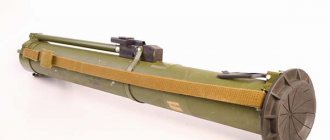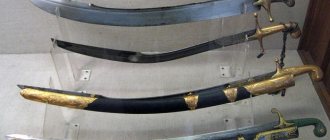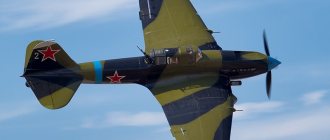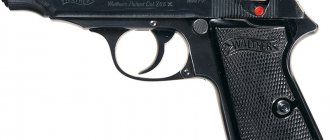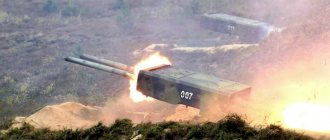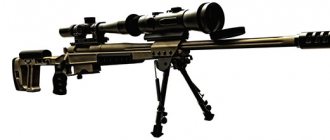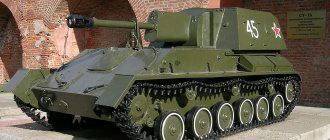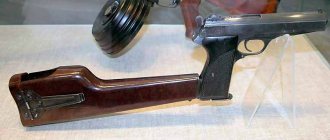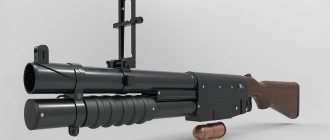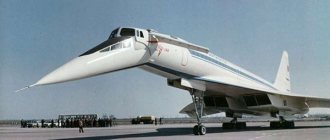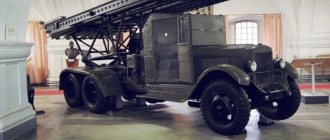The RPG-18 “Mukha” anti-tank rocket launcher was created to destroy enemy shelters, fortifications and armored targets, as well as to eliminate manpower located in urban structures and light shelters. The grenade launcher is a disposable weapon.
The RPG-18 is the Soviet equivalent of the M72 Lowe grenade launcher produced in America in the 1960s. At the moment, the armor penetration of the RPG-18 is no longer sufficient to destroy the latest generation of armored tanks, but it can be used quite effectively to destroy light vehicles, armored infantry vehicles and fortified fire targets.
The history of the creation of the formidable “beast”
“Disposable” grenade launchers are not new to the world history of weapons: back during World War II, Germany became the first country to present the world with a terrible creation - the Panzerfaust grenade launcher, capable of penetrating tank armor.
Only almost 20 years later, Soviet military engineers, led by the country's leading designers V.N. Baraboshkin and I.E. Rogozin created a unique weapon.
The basis was taken from a German idea, improved several years earlier by the Americans (M-72 “Low”), and turned into the RPG-18 (rocket-propelled anti-tank grenade) system.
The name “Fly” instantly stuck to it. During testing and testing of combat characteristics, the grenade launcher was given such an unusual nickname due to the unique design of its front sight (more on the characteristics a little later).
It became the first of its kind (for the USSR) disposable rocket-propelled grenade capable of penetrating tank armor.
"Mukha" was put into service with the Soviet Army and was successfully operated until the beginning of the 90s.
The model has now been discontinued due to its lack of efficiency: it is not able to successfully withstand modern tanks equipped with more durable armor.
Shovel grenade launcher "Option"
Sometimes unique designs appear, for example, the Variant grenade launcher-shovel. Something similar, a shovel-mortar, was used in the initial period of the Great Patriotic War, but such a weapon turned out to be not very effective. This idea still haunts developers, as it is tempting to add the functions of a support weapon to the sapper shovel. In the grenade launcher version, a wooden plug is removed from the shovel, which plays the role of a handle.
When the shovel is pressed into the ground, this product works like a mortar, but there is the option of firing with the emphasis on the shoulder or from the hand. The weight of such a shovel-grenade launcher is 2 kg. This design never went into production. All of these grenade launchers were originally developed as military weapons, although they are widely used in special operations. Nevertheless, special types of weapons were also developed for the special services, mainly for firing gas grenades.
Features of the device and performance characteristics
The design of the RPG-18 “Mukha” anti-tank grenade launcher consists of the following parts: the installation and the charge itself (missile). The main elements of the first:
- The smoothbore design is represented by two pipes: external and internal. The first is made of a combined material (fiberglass). The front sight is attached to it, and the casing allows you to securely fasten the elements of the trigger mechanism. The second is made of aluminum alloy. Equipped with a socket for mounting impact and locking mechanisms;
- Impact trigger mechanism. Designed to fire a charge;
- Locking mechanism. Located at the rear of the structure. The main task: to block the striking mechanism in the “stowed” position and transfer the weapon to combat mode;
- Guide. The main function is to combine the pipes of the structure;
- Aim. Represented by a front sight and a diopter. The first is located near the barrel. Equipped with glass of a certain marking, allowing you to calculate the distance for the sight. The second is located on the outer tube and directs the charge precisely to the target.
Next, we present to your attention the main performance characteristics (list of main technical and tactical parameters) of the grenade launcher:
| Characteristic name | Index |
| Caliber, mm | 64 |
| Weight, kg | 2,6 |
| Charge weight, kg | 1,4 |
| Length, mm (travelling/combat position) | 705/1050 |
| Initial projectile speed, m/s | 114 |
| Maximum distance for sight, m | 400 |
| Armor penetration, mm | 150 |
What is RPG 18
It would be wrong to say that the RPG-18 or “Mukha” grenade launcher was the first such weapon in the world. Prototypes of modern grenade launchers were used by German troops during the Second World War. Of course, since that time this weapon has changed a lot, and the functionality has improved (Figure 1).
Figure 1. This is what a grenade launcher and its ammunition looks like
Despite the fact that the principle of operation of the anti-tank grenade launcher is in many ways similar to its German “ancestors,” for the 70s, when the RPG-18 was created, this weapon became a real breakthrough.
Existing modifications
After the “Fly” ceased to satisfy the requirements of the military, its work was continued by the following rocket-propelled grenades known by the names:
- RPG-22 "Net";
- RPG-26 "Aglen";
- RPG-27 "Meadowsweet";
- RPG-28 "Cranberry".
There were several reasons for improving the fly. Firstly, the weapon did not have high armor penetration rates (for “Netto” it was increased to 200 mm, and for “Aglen” - as much as 400 mm).
Secondly, the two-pipe design of the RPG-18 was somewhat unsuccessful. The solution to this problem was the introduction of a retractable nozzle instead of the internal pipe on the “Netto”; in addition, there was no provision for transfer from the combat position to the transport position.
This deficiency was corrected only at Agleni.
“Aglen” is considered the most successfully modernized version of the RPG-18. Among its shortcomings (and even then, it’s a stretch) of the model, one can note only a slight increase in weight (+200 g).
Currently, the following successors of the “Mukha” are being mass-produced: RPG-27 “Meadowsweet” and RPG-28 “Cranberry”.
They are distinguished by increased armor penetration, but at the same time they also have more impressive sizes and tandem warheads.
Design
The RPG-7 is a lightweight dynamo-reactive (no recoil when fired) weapon.
The grenade launcher and shot were based on the reusable recoilless launcher and shot with an over-caliber warhead, which had proven themselves in the RPG-2. The grenade launcher consists of a barrel with optical and mechanical sights, a trigger mechanism with a safety catch, and a firing mechanism.
Grenade launcher barrel
The barrel of a grenade launcher consists of a pipe and a pipe and serves to direct the flight of the grenade and remove powder gases when fired. Unlike the RPG-2, the RPG-7 grenade launcher has an extension of the barrel in its middle part - a charging chamber - to more fully utilize the energy of the propellant charge, and a bell in the breech - to ensure recoillessness of the complex.
Trigger mechanism
The trigger mechanism is used to release the hammer, strike the firing pin, and engage the safety.
Sights
PGO-7V1 optical sight reticle - sight scale, 2 - lateral correction scale, 3 - rangefinder scale
Bulgarian soldier with a training (MILES) version of the RPG-7 grenade launcher, equipped with a collimator sight
Mechanical sight
A mechanical sight is used in case of damage (failure) of the optical sight.
Optical sight
The main one for the RPG-7 is the PGO-7 optical sight (or its modifications PGO-7V, PGO-7V-2, PGO-7V-3). The optical sight is designed to monitor the battlefield, determine the distance to the target, introduce corrections for the range and speed of the target, taking into account the ballistics of various ammunition, and point the grenade launcher at the target, taking into account the corrections.
The sight is an optical system of lenses and prisms, enclosed in a sealed metal case filled with dry nitrogen to prevent fogging. The optical sight provides a fixed apparent target magnification of 2.7 times. The sight is equipped with a set of light filters that improve visibility in difficult weather conditions. To prevent unmasking glare from the sun and contamination, the sight is equipped with a rubber cap that fits onto the lens.
The PGO-7V sight reticle has a developed correction scale, as well as a rangefinder scale, which allows you to quickly determine the range to a “tank” type target (2.7 m high). The handwheel provides input of aiming angles in the range of 0-51.2 artillery units, and the aiming mark on the reticle: 0-45.7. In poor lighting conditions, the sight reticle can be illuminated. The backlight lamp uses galvanic batteries A316 or 2РЦ63.
The sight retains its characteristics over a wide temperature range (from −50 to +50 °C), and is also able to withstand high mechanical loads.
Night optical sight
The RPG-7 grenade launcher can be equipped with first-generation night sights (such as the specialized PGN-1 grenade launcher night sight or the NSPUM universal night sight (product 1PN58)) or second-generation NSPU-3 night sights.
For a grenade launcher with a night sight, a light-blocking mechanism is additionally introduced, which prevents the sight from being illuminated by the flame of its own shot.
Universal sighting device
The universal sighting device is a mechanical device weighing 0.55 kg for introducing corrections into the optical sight. It has been used since 2001 in grenade launchers of the RPG-7V2 (RPG-7D3) modifications in conjunction with an optical sight. Allows you to significantly increase the target firing range of thermobaric (TBG-7V) and fragmentation (OG-7V) grenades: up to 550 and 700 meters, respectively.
Other types of sights
Together with the RPG-7, other sighting devices (including homemade ones) are also used: from homemade mechanical sights to replace damaged original ones, to high-tech laser and collimator sights. Most of these devices do not allow corrections for range and target movement, so they are effective only at short ranges.
Combat use
To assess the feasibility of using the weapon in question, it is necessary to understand that this is rather not a grenade launcher, but a rocket-propelled anti-tank hand grenade, which can be used by any fighter trained in its use when an enemy combat vehicle appears or an enemy firing point is detected.
The RPG-18 is used by rifle units in collisions with enemy armored vehicles.
Due to its excellent combat characteristics, it can be used with equally high efficiency to destroy enemy personnel (it has an effective anti-personnel fragmentation effect), for the destruction of small structures, shelters and buildings.
Since the “fly” is considered a high-speed weapon, according to the instructions, increased safety precautions should be observed when using it.
For example, it is prohibited to fire a gun if there are people behind at a distance of less than 30 m at an angle of less than 90 degrees.
Currently, “Mukha” is in service with the following countries: Ukraine, Uzbekistan, Armenia, Georgia, Latvia, etc.
Oddly enough, the model did not find active use in the army. Only after it was taken out of production, after the collapse of the USSR, the gun was able to show all its power, but, unfortunately, in the wrong hands: during the Chechen War, militants used it to destroy more than a dozen Russian tanks. Dynamic protection of tanks does not help with the massive use of RPGs.
Flamethrower "Bumblebee"
The Shmel hand-held infantry flamethrower is especially popular. Caliber 93 mm, length 920 mm, weight 11 kg. The sighting range of the weapon is up to 600 meters, the flight range of the capsule is up to 1000 meters. Thermobaric warhead. Its power is equivalent to that of a 122 mm howitzer projectile. This is a powerful weapon, from which field-type fortifications are poorly protected. The design of the “Bumblebee” is extremely simple. Trigger, safety, folding handle and folding sight. There is also a folding handle on the front for easy holding.
The weapon is disposable and is thrown away after use. The RPO-A can be equipped with an optical sight. The flamethrower has a strap for carrying it. Like every rocket weapon, the Bumblebee has a danger zone, the destruction sector is equal to PO degrees, at a distance of 45 meters. The distance to the wall is at least 6 meters. The presence of such powerful and portable weapons significantly expands the capabilities of special forces.
Mark on history
Here are some interesting facts from the “life” of the famous disposable rocket-propelled grenade:
- For the first time, “Mukha” was used in real conditions in Southeast Asia;
- The RPG-18 was not considered in military documents as a grenade launcher due to the fact that after its use it was deregistered;
- Due to a number of features, such as light weight, ease of use, efficiency and low cost, the weapon began to be actively used in a number of terrorist organizations, mercenary groups, partisans, etc.;
- Unpleasant and at the same time curious cases were recorded when, being in a combat position, the RPG-18 was not used in action. As a result, the fighter was forbidden to fold it until the moment of firing at a specific target.
Principle of operation
When the RPG-18's tubes diverge for firing, the grenade takes up a firing position in the part of the barrel located behind the shooter's back. To transfer the RPG-18 to a combat position, it is necessary to move the pipes apart. The correctness of their expansion occurs due to the presence of a rigidly fixed ruler, which moves linearly along the groove of the pipe body located outside. The purpose of the ruler when folded is to hold the lock of the protective cover and the sighting sight in the lowered position. In preparation for shooting, the entire mechanism is activated and the diopter is released.
The direction of the internal tube of the RPG (photos of the design can be found on some military technical sites) when moving the grenade launcher into the firing position is ensured by a guide ruler riveted to its rear end. During travel movement of the RPG-18, this element of the mechanism is located in a special guide casing, shaped like a trench, on top of the outer pipe. The front of the ruler protrudes from the housing and clamps the mechanism to hold the front sight and cover in the closed position. To move the pipes apart, it is necessary to open the back cover, while the ruler moves backward along the casing groove, unlocking the holding mechanism. The front sight is raised and the cover is simultaneously released. At the same time, the spring-loaded diopter also rises.
Special plates hold the grenade by the stabilizer in a stationary position in the body of the inner tube. As the grenade moves, the plates are destroyed and detached from the stabilizer feather as the grenade exits the common tube. In the rear compartment of the inner tube there is a primer for igniting the grenade, a striking mechanism and a mechanism that blocks the grenade from being accidentally fired.
